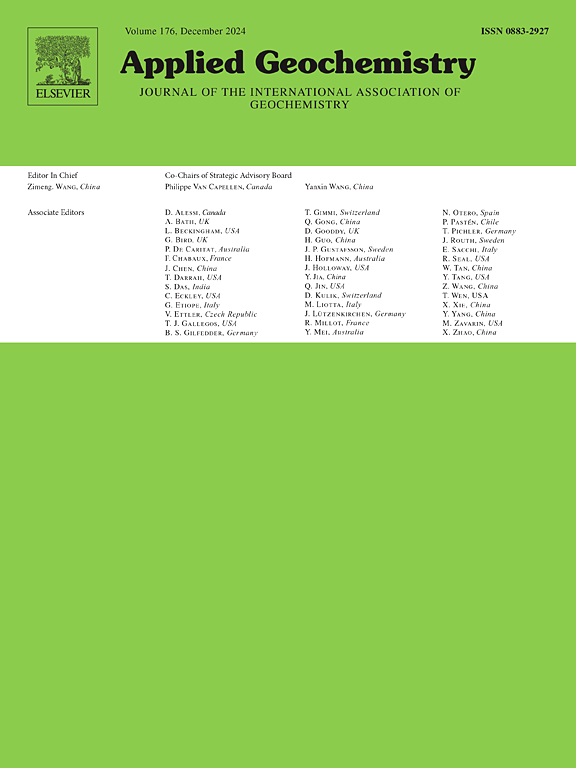Comparative analysis of sea salt species in snow samples from Svalbard using ICP-QMS and IC techniques
IF 3.4
3区 地球科学
Q1 GEOCHEMISTRY & GEOPHYSICS
引用次数: 0
Abstract
Inductively coupled plasma quadrupole mass spectrometry (ICP-QMS) and ion chromatography (IC) paired with either a conductivity detector (IC-CD) or single quadrupole mass spectrometer (IC-MS) are essential techniques in environmental analysis. Previous research has demonstrated robust agreement when applying these methods to Antarctic ice cores and snow samples. However, the high concentrations of sea spray and mineral dust found in Arctic snow samples pose distinct challenges, that might impact the accuracy and precision of measurements, despite the existing efforts to minimise matrix effects. In particular, the higher amount of dust in the Arctic snow/ice samples could present an additional source for insoluble elements typically found in sea spray that is insoluble and thus undetectable by IC, causing a divergency between the results obtained from the two techniques. Therefore, it is crucial to comprehend how these factors influence the efficacy of ICP-QMS and IC techniques in polar research. This study provides a detailed comparison of these methods in quantifying sea salt species – sodium (Na), potassium (K), magnesium (Mg), and bromine (Br) – in surface snow samples collected at Svalbard. By cross-validating IC and ICP-QMS for these tracers, the study assesses each method's accuracy, sensitivity, and precision, providing valuable insights into their optimal application in polar research and climate studies.
利用ICP-QMS和IC技术对斯瓦尔巴群岛雪样中海盐种类进行比较分析
电感耦合等离子体四极杆质谱(ICP-QMS)和离子色谱(IC)与电导率检测器(IC- cd)或单四极杆质谱仪(IC- ms)配对是环境分析中必不可少的技术。在将这些方法应用于南极冰芯和雪样本时,先前的研究已经证明了强有力的一致性。然而,在北极雪样本中发现的高浓度海水喷雾和矿物粉尘构成了明显的挑战,这可能会影响测量的准确性和精度,尽管目前正在努力将基质效应降到最低。特别是,北极雪/冰样品中较高的粉尘量可能是不溶性元素的额外来源,这些不溶性元素通常存在于海雾中,因此IC无法检测到,从而导致两种技术所得结果之间的差异。因此,了解这些因素如何影响ICP-QMS和IC技术在极地研究中的有效性至关重要。本研究提供了这些方法在定量海盐种类-钠(Na),钾(K),镁(Mg)和溴(Br) -在斯瓦尔巴群岛收集的表面雪样品中的详细比较。通过交叉验证这些示踪剂的IC和ICP-QMS,该研究评估了每种方法的准确性、灵敏度和精密度,为它们在极地研究和气候研究中的最佳应用提供了有价值的见解。
本文章由计算机程序翻译,如有差异,请以英文原文为准。
求助全文
约1分钟内获得全文
求助全文
来源期刊

Applied Geochemistry
地学-地球化学与地球物理
CiteScore
6.10
自引率
8.80%
发文量
272
审稿时长
65 days
期刊介绍:
Applied Geochemistry is an international journal devoted to publication of original research papers, rapid research communications and selected review papers in geochemistry and urban geochemistry which have some practical application to an aspect of human endeavour, such as the preservation of the environment, health, waste disposal and the search for resources. Papers on applications of inorganic, organic and isotope geochemistry and geochemical processes are therefore welcome provided they meet the main criterion. Spatial and temporal monitoring case studies are only of interest to our international readership if they present new ideas of broad application.
Topics covered include: (1) Environmental geochemistry (including natural and anthropogenic aspects, and protection and remediation strategies); (2) Hydrogeochemistry (surface and groundwater); (3) Medical (urban) geochemistry; (4) The search for energy resources (in particular unconventional oil and gas or emerging metal resources); (5) Energy exploitation (in particular geothermal energy and CCS); (6) Upgrading of energy and mineral resources where there is a direct geochemical application; and (7) Waste disposal, including nuclear waste disposal.
 求助内容:
求助内容: 应助结果提醒方式:
应助结果提醒方式:


